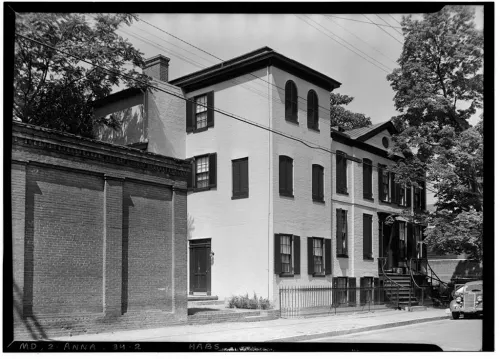Share what you know,
and discover more.
Share what you know,
and discover more.
Mar 20, 2023

-

- Charmaine Bantugan
Hammond-Harwood House
Built in 1774, for Matthias Hammond (d.1786). It was designed by William Buckland from a plate in Palladio's Four Books of Architecture (1570) and was modelled on the Villa Pisani in Montagnana, Northern Italy. It ranks with the likes of Blandfield as one of the most sophisticated examples of domestic Georgian architecture in Colonial America and since 1940 has been open to the public as a house museum. Matthias Hammond never occupied his townhouse, he removed to his plantation from 1776 and for the last remaining ten years of his life leased it to various tenants, with Judge Jeremiah Chase occupying the north-east wing. A bachelor, Hammond left the property to his nephews, John, and then Philip Hammond, who in 1810 sold the house to Ninian Pinkney. Pinkney flipped it on the following year for a quick profit to Judge Chase who bought the house as a wedding present for his daughter, Frances Townley Chase Loockerman. Various of Judge Chase's descendants made their home here up until 1924 when his great-granddaughter (Hester Ann Harwood) - who was also a great-great-granddaughter of the original architect, William Buckland - died. From 1926 to 1940 it was owned by St. John's College and since then has its been operated as a house museum.
Hammond-Harwood House
Built in 1774, for Matthias Hammond (d.1786). It was designed by William Buckland from a plate in Palladio's Four Books of Architecture (1570) and was modelled on the Villa Pisani in Montagnana, Northern Italy. It ranks with the likes of Blandfield as one of the most sophisticated examples of domestic Georgian architecture in Colonial America and since 1940 has been open to the public as a house museum. Matthias Hammond never occupied his townhouse, he removed to his plantation from 1776 and for the last remaining ten years of his life leased it to various tenants, with Judge Jeremiah Chase occupying the north-east wing. A bachelor, Hammond left the property to his nephews, John, and then Philip Hammond, who in 1810 sold the house to Ninian Pinkney. Pinkney flipped it on the following year for a quick profit to Judge Chase who bought the house as a wedding present for his daughter, Frances Townley Chase Loockerman. Various of Judge Chase's descendants made their home here up until 1924 when his great-granddaughter (Hester Ann Harwood) - who was also a great-great-granddaughter of the original architect, William Buckland - died. From 1926 to 1940 it was owned by St. John's College and since then has its been operated as a house museum.
Mar 20, 2023
Hammond-Harwood House
Built in 1774, for Matthias Hammond (d.1786). It was designed by William Buckland from a plate in Palladio's Four Books of Architecture (1570) and was modelled on the Villa Pisani in Montagnana, Northern Italy. It ranks with the likes of Blandfield as one of the most sophisticated examples of domestic Georgian architecture in Colonial America and since 1940 has been open to the public as a house museum.Matthias Hammond never occupied his townhouse, he removed to his plantation from 1776 and for the last remaining ten years of his life leased it to various tenants, with Judge Jeremiah Chase occupying the north-east wing. A bachelor, Hammond left the property to his nephews, John, and then Philip Hammond, who in 1810 sold the house to Ninian Pinkney. Pinkney flipped it on the following year for a quick profit to Judge Chase who bought the house as a wedding present for his daughter, Frances Townley Chase Loockerman. Various of Judge Chase's descendants made their home here up until 1924 when his great-granddaughter (Hester Ann Harwood) - who was also a great-great-granddaughter of the original architect, William Buckland - died. From 1926 to 1940 it was owned by St. John's College and since then has its been operated as a house museum.
Posted Date
Mar 20, 2023
Historical Record Date
Mar 20, 2023
Source Name
House Histree
Source Website
Delete Story
Are you sure you want to delete this story?










